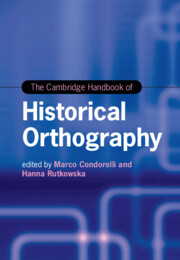Book contents
- The Cambridge Handbook of Historical Orthography
- cambridge handbooks in language and linguistics
- The Cambridge Handbook of Historical Orthography
- Copyright page
- Contents
- Figures
- Tables
- Contributors
- Abbreviations
- Part I Introduction
- Part II Structures and Theories
- Part III Organization and Development
- Part IV Empirical Approaches
- Part V Explanatory Discussions
- 21 Scribes and Scribal Practices
- 22 Orthographic Norms and Authorities
- 23 Networks of Practice across English and Dutch Corpora
- 24 Literacy and the Singular History of Norwegian
- 25 Authorship and Gender
- 26 Sociolinguistic Variables in English Orthography
- 27 Sociolinguistic Implications of Orthographic Variation in French
- 28 Orthography and Language Contact
- 29 Discourse and Sociopolitical Issues
- 30 Transmission and Diffusion
- 31 Analogy and Extension
- Bibliography
- Name Index
- Subject Index
26 - Sociolinguistic Variables in English Orthography
from Part V - Explanatory Discussions
Published online by Cambridge University Press: 28 September 2023
- The Cambridge Handbook of Historical Orthography
- cambridge handbooks in language and linguistics
- The Cambridge Handbook of Historical Orthography
- Copyright page
- Contents
- Figures
- Tables
- Contributors
- Abbreviations
- Part I Introduction
- Part II Structures and Theories
- Part III Organization and Development
- Part IV Empirical Approaches
- Part V Explanatory Discussions
- 21 Scribes and Scribal Practices
- 22 Orthographic Norms and Authorities
- 23 Networks of Practice across English and Dutch Corpora
- 24 Literacy and the Singular History of Norwegian
- 25 Authorship and Gender
- 26 Sociolinguistic Variables in English Orthography
- 27 Sociolinguistic Implications of Orthographic Variation in French
- 28 Orthography and Language Contact
- 29 Discourse and Sociopolitical Issues
- 30 Transmission and Diffusion
- 31 Analogy and Extension
- Bibliography
- Name Index
- Subject Index
Summary
This chapter clarifies that the treatment and reliability of orthographic variables as linguistic variables has already been tested with the application of both macroscopic and microscopic approaches to digitalized historical materials. Patterns of variation and change in past periods of a given language have been evidenced through the observation of its users’ sociolinguistic behavior in social interaction. The recent prolific research output in historical sociolinguistics reflects the growth of interest in style and register within the field. The role of new genres and text types (e.g. travel accounts, court records, recipes, diaries, and letters) is thus also being highlighted as materials worth studying for both interspeaker and intraspeaker variation. The chapter explores the indexical potential of orthographic variation in style, register, genre and text types. The extralinguistic factors conditioning the use of different spelling forms in cases of variability are usually based on production, geographical location, sociodemographics (sex, age, rank), social networks, text type (and genre), style, register and medium (handwritten vs. printed). In earlier periods, when correspondence and other ego-documents were probably the most frequent means of written communication and without the existence of a well-established and fixed standard variety, orthographic variation constituted a source of social meaning.
- Type
- Chapter
- Information
- The Cambridge Handbook of Historical Orthography , pp. 520 - 536Publisher: Cambridge University PressPrint publication year: 2023

